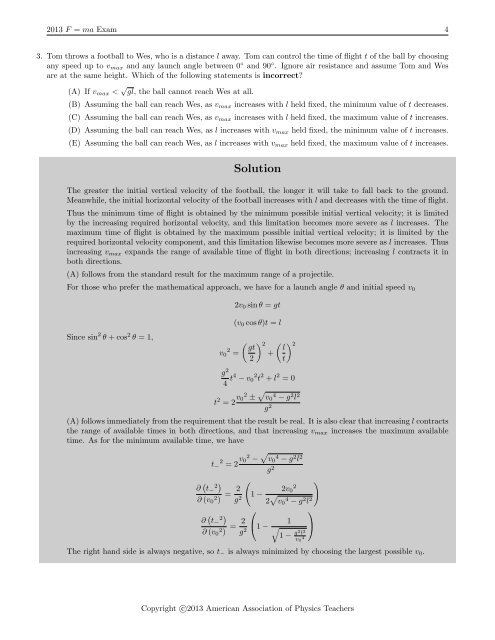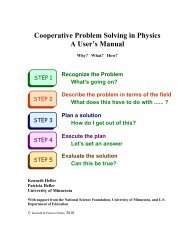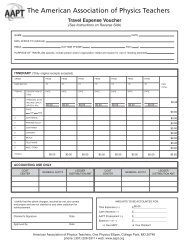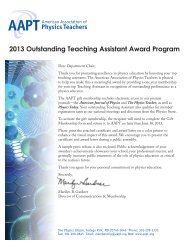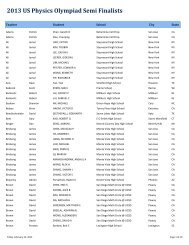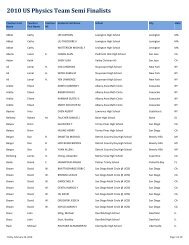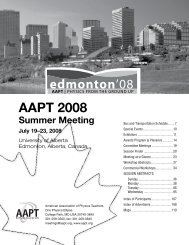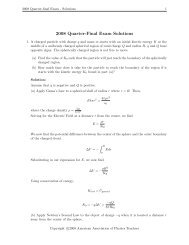Solution - American Association of Physics Teachers
Solution - American Association of Physics Teachers
Solution - American Association of Physics Teachers
You also want an ePaper? Increase the reach of your titles
YUMPU automatically turns print PDFs into web optimized ePapers that Google loves.
2013 F = ma Exam 43. Tom throws a football to Wes, who is a distance l away. Tom can control the time <strong>of</strong> flight t <strong>of</strong> the ball by choosingany speed up to v max and any launch angle between 0 ◦ and 90 ◦ . Ignore air resistance and assume Tom and Wesare at the same height. Which <strong>of</strong> the following statements is incorrect?(A) If v max < √ gl, the ball cannot reach Wes at all.(B) Assuming the ball can reach Wes, as v max increases with l held fixed, the minimum value <strong>of</strong> t decreases.(C) Assuming the ball can reach Wes, as v max increases with l held fixed, the maximum value <strong>of</strong> t increases.(D) Assuming the ball can reach Wes, as l increases with v max held fixed, the minimum value <strong>of</strong> t increases.(E) Assuming the ball can reach Wes, as l increases with v max held fixed, the maximum value <strong>of</strong> t increases.<strong>Solution</strong>The greater the initial vertical velocity <strong>of</strong> the football, the longer it will take to fall back to the ground.Meanwhile, the initial horizontal velocity <strong>of</strong> the football increases with l and decreases with the time <strong>of</strong> flight.Thus the minimum time <strong>of</strong> flight is obtained by the minimum possible initial vertical velocity; it is limitedby the increasing required horizontal velocity, and this limitation becomes more severe as l increases. Themaximum time <strong>of</strong> flight is obtained by the maximum possible initial vertical velocity; it is limited by therequired horizontal velocity component, and this limitation likewise becomes more severe as l increases. Thusincreasing v max expands the range <strong>of</strong> available time <strong>of</strong> flight in both directions; increasing l contracts it inboth directions.(A) follows from the standard result for the maximum range <strong>of</strong> a projectile.For those who prefer the mathematical approach, we have for a launch angle θ and initial speed v 0Since sin 2 θ + cos 2 θ = 1,v 0 2 =2v 0 sin θ = gt(v 0 cos θ)t = l( ) 2 ( 2gt l+2 t)g 24 t4 − v 0 2 t 2 + l 2 = 0t 2 = 2 v 0 2 ± √ v 04 − g 2 l 2g 2(A) follows immediately from the requirement that the result be real. It is also clear that increasing l contractsthe range <strong>of</strong> available times in both directions, and that increasing v max increases the maximum availabletime. As for the minimum available time, we havet − 2 = 2 v 0 2 − √ v 04 − g 2 l 2g 2∂ ( t ) ()2 −∂ (v 02 ) = 2 22v 0g 2 1 −2 √ v 04 − g 2 l 2∂ ( t ) ⎛2 −∂ (v 02 ) = 2 ⎝1g 2 −1√1 − g2 l 2v 4 0The right hand side is always negative, so t − is always minimized by choosing the largest possible v 0 .⎞⎠Copyright c○2013 <strong>American</strong> <strong>Association</strong> <strong>of</strong> <strong>Physics</strong> <strong>Teachers</strong>


